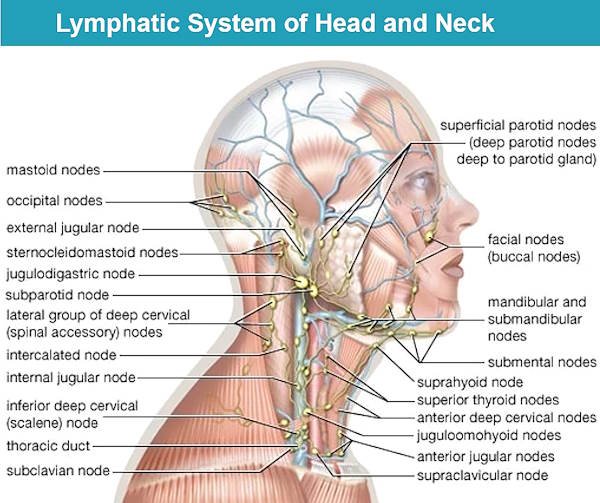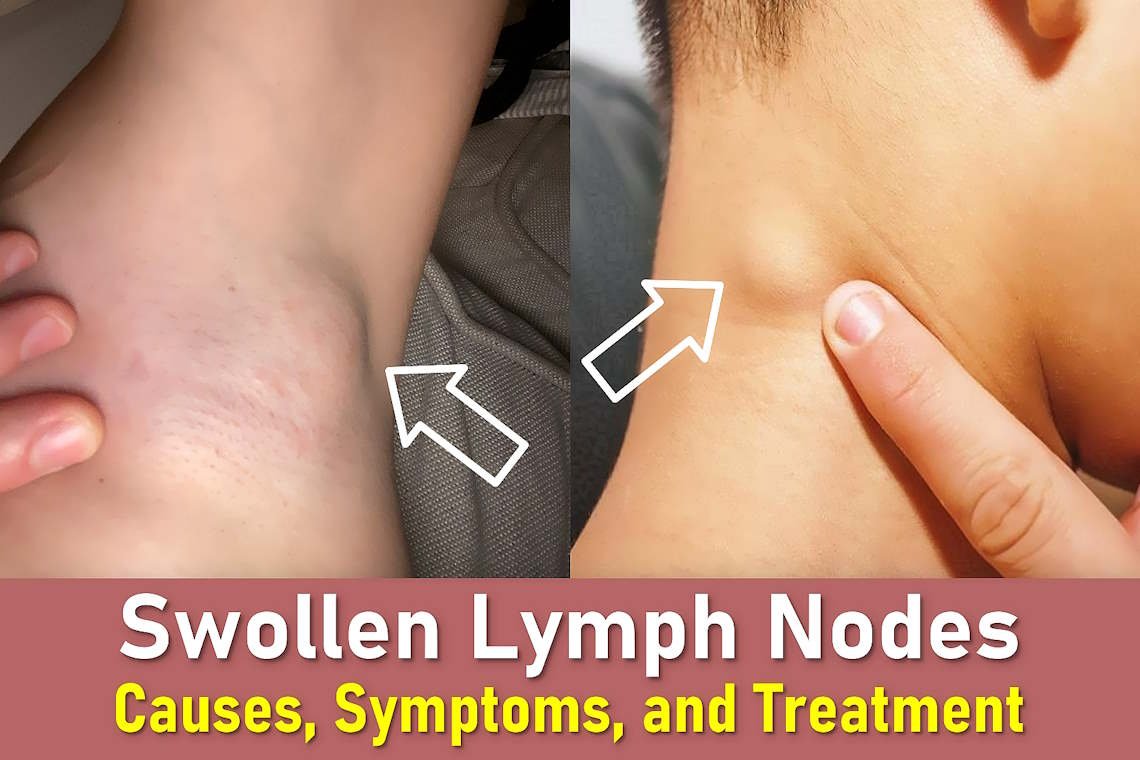Swollen Lymph Nodes: Causes, Symptoms, and Treatment
Swollen lymph nodes, often referred to as swollen glands in the neck or other areas, are a common sign that your body is fighting an infection. While infections are the most frequent cause, persistent swelling, especially when the reason is unclear, should be evaluated by a doctor, particularly if it lasts longer than two weeks.
What Are Lymph Nodes?
Lymph nodes are small, bean-shaped glands that play a crucial role in your immune system. They filter lymph, a clear fluid that circulates through the lymphatic system, trapping bacteria, viruses, and damaged cells. When you have an infection, these glands may swell as they work to combat the invaders.

Common locations for swollen lymph nodes include:
- The sides or back of the neck (cervical lymph nodes)
- Under the jaw (submandibular lymph nodes)
- Behind the ears (lymph nodes around ear)
- Above the collarbone (supraclavicular lymph nodes)
- The groin (inguinal lymph nodes)
- The occipital region (lymph nodes back of head)
These glands are interconnected by a network of lymphatic vessels, which transport lymph throughout the body. Lymph contains white blood cells (lymphocytes) that help fight infections, making the lymphatic system a key part of your immune defense.
Why Do Lymph Nodes Swell?
Swollen lymph nodes, or lymphadenopathy, typically occur when your body is responding to an infection or illness. For example:
- A sore throat from a cold or COVID-19 may cause swollen lymph nodes in the neck.
- A skin infection could lead to enlarged lymph nodes near the affected area.
- In rare cases, cancer may cause persistent swelling in the lymph nodes.
When lymph nodes detect harmful substances like bacteria or viruses, they produce more white blood cells, leading to noticeable swelling. This is often accompanied by other symptoms, depending on the underlying cause.
Symptoms of Swollen Lymph Nodes
Swollen lymph nodes themselves may feel tender or painful to the touch. Depending on their location, you might notice:
- In the neck (cervical nodes): Often linked to throat infections, colds, or dental issues. Symptoms may include coughing, fever, or a runny nose.
- Behind the ear (lymph node behind ear): Could indicate an ear infection or skin condition.
- In the groin (swollen nodes in groin): May occur with pelvic infections, causing discomfort when walking or bending.
Other general symptoms that may accompany swollen lymph nodes include fatigue, chills, night sweats, or unexplained weight loss. If swelling persists without an obvious cause, medical evaluation is recommended.
What Causes Swollen Lymph Nodes?
Under normal conditions, lymph nodes are small, bean-shaped structures about the size of a pea. They are part of the immune system, quietly working to filter harmful substances and help your body fight infections. In most cases, you may not even notice them. However, when they become active in fighting an illness or reacting to other health conditions, they can swell to the size of a marble or even larger. This swelling makes them easier to feel under the skin in certain areas, such as the neck (cervical lymph nodes) or behind the ear. Lymph nodes located deeper inside the body, such as in the chest or abdomen, may not be visible but can still cause pressure or discomfort when enlarged.
Common Causes: Infections
Infections are by far the most frequent reason lymph nodes swell. When your body detects bacteria, viruses, or other harmful substances, the nearby lymph nodes trap these invaders and increase production of immune cells to fight them. This process causes them to enlarge and sometimes feel tender. Once the infection clears, the swelling usually goes down within a week or two. Examples include:
- Neck swelling (swollen lymph nodes in neck): Commonly caused by throat infections, tonsillitis, dental abscesses, or viral colds.
- Back of the head (occipital lymph nodes): Can enlarge due to scalp conditions such as dermatitis, fungal infections, or head lice.
- Armpit (axillary lymph nodes): Often swell after skin infections, minor injuries, or shaving irritation affecting the arm or upper chest.
- Groin (swollen nodes in groin): May react to infections in the legs, genital area, or skin conditions like athlete’s foot.
- Widespread swelling: Viral illnesses such as flu, chickenpox, or mononucleosis can cause lymph nodes in several areas, including the neck, armpits, and groin, to enlarge at the same time.
Less Common Causes: Cancers and Systemic Diseases
While most swollen lymph nodes are harmless and temporary, in some cases they can signal more serious conditions, such as cancer or autoimmune diseases. Cancer cells can sometimes spread to nearby lymph nodes, causing a gradual and usually painless enlargement. Examples include:
- Breast cancer: May spread to lymph nodes in the armpit.
- Throat or lung cancer: Can cause swelling of lymph nodes in the neck or deep inside the chest.
- Lymphoma or leukemia: These cancers of the lymphatic or blood system can cause multiple lymph nodes to swell at the same time, often in the neck, groin, and under the jaw (swollen lymph nodes under jaw).
Swelling from these causes typically develops slowly and may remain unnoticed at first, since it is often not painful in the early stages.
Other Uncommon Causes
There are also less common reasons lymph nodes can become enlarged, such as:
- Medication reactions: Certain drugs, including some antibiotics or antiseizure medicines, can trigger lymph node swelling as a side effect.
- Dental procedures: Oral surgeries, gum infections, or even routine dental work can temporarily enlarge nodes under the chin (lump under chin) or along the jawline.
- Autoimmune diseases: Conditions such as lupus or rheumatoid arthritis can cause the immune system to attack healthy tissues, leading to widespread inflammation that includes the lymph nodes.
- Rare infections: Illnesses like HIV, tuberculosis (TB), or Kawasaki disease may cause persistent or unusual lymph node swelling.
Because swollen lymph nodes can result from many different conditions, the best approach is to pay attention to how long they last, whether they are tender, and if other symptoms are present. Persistent, hard, or painless swelling without a clear cause should always be evaluated by a healthcare professional.
How to Check for Swollen Lymph Nodes
Swollen lymph nodes can range in size from a small pea to larger than a cherry. You may notice them when they become tender to the touch or cause discomfort during certain movements. For example:
- Neck and jaw area (swollen lymph nodes under jaw): These may hurt when turning your head or chewing. You can often feel them by gently running your fingers along your neck below the jawline.
- Behind the ear (lymph node behind ear): These might become noticeable when wearing glasses or touching the area.
- Back of the head (occipital lymph nodes): These may be felt when combing hair or resting your head.
While some swelling is normal during infections, persistent or painless enlargement should be evaluated by a doctor.
When to See a Doctor About Swollen Lymph Nodes
While swollen lymph nodes often accompany common infections and aren’t cause for alarm, you should consult a healthcare provider if:
- Swelling persists for more than two weeks without improvement
- Nodes appear without an obvious infection or cause
- You notice swollen lymph nodes above or below the collarbone (lump on clavicle)
- Nodes feel hard, immovable, or continue growing
- You experience accompanying symptoms like fever, night sweats, or unexplained weight loss
Diagnosing Swollen Lymph Nodes
When you visit your healthcare provider for swollen lymph nodes, they’ll typically follow these steps:
Medical History Review
Your doctor will ask about:
- Recent illnesses or injuries
- Your complete medical history
- Any medications you’re taking
- Other symptoms you’ve noticed
Physical Examination
During the exam, your doctor will:
- Measure the size of swollen nodes
- Check for tenderness
- Assess consistency (soft and movable vs. hard and fixed)
- Note any changes over time
Diagnostic Tests
Depending on the findings, your doctor may recommend:
- Blood tests: To check for infections or systemic conditions
- Imaging studies: Such as ultrasound (especially for nodes in neck or groin) or CT scans
- Biopsy: If cancer is suspected, a small sample may be taken for testing
Treatment Options for Swollen Lymph Nodes
When Treatment Isn’t Needed
Many cases of swollen lymph nodes, especially those caused by minor viral infections, resolve on their own without treatment. Your doctor may simply recommend monitoring them if:
- The swelling is decreasing
- There are no other concerning symptoms
- The nodes are soft and movable
Treating Infection-Related Swelling
For bacterial infections causing swollen nodes, treatment may include:
- Antibiotics to fight the infection
- Pain relievers like acetaminophen or ibuprofen
- Warm compresses to ease discomfort
Cancer-Related Swelling
If swollen lymph nodes are caused by cancer, treatment focuses on the underlying condition and may involve:
- Surgical removal of affected nodes
- Radiation therapy
- Chemotherapy
- Targeted drug therapies
Your doctor will develop a personalized treatment plan based on your specific diagnosis and overall health.
Home Care and When to Seek Help
While waiting for swollen lymph nodes to improve, you can:
- Apply warm compresses to the area
- Get plenty of rest
- Stay hydrated
Seek immediate medical attention if you experience:
- Nodes that continue to grow
- Hard, fixed nodes (especially in the neck or above the collarbone)
- Unexplained weight loss or night sweats
- Swelling lasting more than 2-4 weeks
Preventing Swollen Lymph Nodes
While you can’t prevent lymph nodes from reacting to infections, you can reduce your risk of conditions that cause them to swell:
- Maintain good hygiene: Regular handwashing helps prevent infections that might lead to swollen lymph nodes in neck or groin areas.
- Practice oral care: Proper dental hygiene prevents infections that could cause swollen lymph nodes under jaw.
- Stay up-to-date on vaccinations: Immunizations for flu, shingles, and other illnesses help prevent infections that trigger lymph node swelling.
- Avoid sharing personal items: Don’t share utensils, towels, or drinks with someone who has a contagious infection.
- Practice safe sex: Use protection to reduce risk of sexually transmitted infections that may cause swollen nodes in groin.
- Monitor medication reactions: Consult your doctor if you suspect your medications are causing lymph node swelling.
- Be cautious with animals: Avoid contact with feral cats and limit outdoor exposure for pet cats to reduce infection risks.
Key Takeaways
Swollen lymph nodes are typically your body’s normal response to infection, commonly appearing in areas like the neck (cervical lymph nodes), behind the ears (lymph nodes around ear), or groin. While usually benign, persistent or unexplained swelling warrants medical evaluation to rule out more serious conditions like lymphoma or metastatic cancer.
Frequently Asked Questions
When should I be concerned about swollen lymph nodes?
Seek medical advice if nodes:
- Are larger than 1 cm (about ½ inch)
- Continue growing in size
- Don’t improve within 2-4 weeks
- Appear with other concerning symptoms
What else could be mistaken for swollen lymph nodes?
Lumps in the neck, armpits, or groin might be:
- Cysts (fluid-filled sacs)
- Lipomas (benign fatty tumors)
- Abscesses
- Salivary gland stones
A healthcare professional can properly diagnose any unusual swelling.
Are swollen lymph nodes dangerous?
Most often, they indicate normal immune activity. However, persistent swelling without infection could signal conditions requiring treatment, including certain cancers or immune disorders.
What does a swollen lymph node feel like?
You might notice:
- Pea- to grape-sized lumps under skin
- Tenderness when touched
- Discomfort with movement (like turning your head)
- Painless swelling (which sometimes requires more urgent evaluation)
Nodes deeper in the body may not be palpable but might cause other symptoms.
How long do swollen lymph nodes in neck typically last?
Swollen lymph nodes in neck caused by common infections usually resolve within 2-3 weeks. Viral infections may take up to 4 weeks for nodes to return to normal size. Persistent swelling beyond 4 weeks warrants medical evaluation.
Can stress cause swollen lymph nodes behind ear?
While stress doesn’t directly cause lymph node swelling, it may weaken your immune system, making you more susceptible to infections that can lead to swollen lymph nodes around ear areas. However, noticeable swelling typically indicates an active infection or other medical condition.
What does a cancerous lymph node in neck feel like?
Cancerous cervical lymph nodes often feel:
- Hard and immovable (like a marble)
- Painless in early stages
- Gradually increasing in size
- Located just above the collarbone (supraclavicular nodes)
However, only a doctor can confirm through proper testing.
Why would a lymph node under jaw swell on one side?
A single swollen lymph node under jaw one side commonly results from:
- Dental infections or abscesses
- Localized skin infections
- Recent dental work
- Early-stage oral cancers (less common)
One-sided swelling should be evaluated if persistent beyond 2 weeks.
Are swollen occipital lymph nodes back of head dangerous?
Swollen occipital lymph nodes are usually caused by scalp conditions (dandruff, lice), skin infections, or viral illnesses. While typically benign, persistent swelling without obvious cause or accompanying symptoms like fever/night sweats should be examined by a doctor.
When should I worry about a lump on clavicle?
Immediately consult a doctor for any noticeable lump on clavicle (collarbone) as this area contains lymph nodes that often indicate serious conditions when swollen, including:
- Lymphoma
- Metastatic cancers (especially from chest/abdomen)
- Tuberculosis
Can allergies cause swollen lymph nodes under jaw?
While uncommon, severe allergic reactions may cause mild, temporary swelling of lymph nodes under jaw. However, significant or persistent swelling is more likely due to infections (like sinusitis or dental issues) and should be evaluated if lasting more than 2 weeks.
What’s the difference between swollen glands in neck vs. actual lymph nodes?
“Swollen glands” is actually a common misnomer – what people feel are swollen cervical lymph nodes in neck. True glands (like salivary or thyroid glands) have different locations and functions. Lymph nodes swell in response to infection, while gland swelling typically indicates other conditions.
How can I tell if swollen nodes in groin are serious?
Seek prompt medical attention for groin lymph nodes that:
- Exceed 1.5 cm in diameter
- Are hard and immovable
- Persist beyond 4 weeks
- Occur with unexplained weight loss or fever
- Show skin changes (redness/dimpling) above them
Can COVID-19 cause swollen lymph nodes behind ear?
Yes, COVID-19 and other viral infections can cause lymph nodes around ear and neck areas to swell. This typically occurs during active infection or post-recovery as part of the immune response. Swelling should subside within 2-4 weeks after illness resolves.









